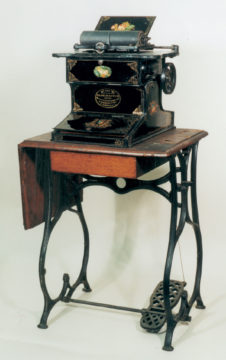Barry Sanders at Cabinet Magazine:
 Twain bangs the keys—swiftly. For Remington’s levers, links, and triggers had made the typewriter resemble in kinetic spirit a kind of machine gun. Making writing rapid-fire, Remington turned a rather staid and quiet activity—writing—into one dominated by force and noise and physical effort. Sharp, metal characters smashed themselves against a platen, hitting with enough percussive force so that each letter impressed itself deeply into the paper. By 1881, with the introduction of the Remington II, a faster machine than its predecessor, sales exploded. From 1881 to 1890, typists increased in number from 5,000 to 33,400; and by 1900, according to census figures, America could boast 112,600 typists and stenographers. A good typist developed a distinctive rhythm, clacking out line after continuous line. A truly fast typist commanded attention. And respect. And sometimes even suspicion. At the Rosenberg spy trial, in 1952, the prosecuting attorney sharpened the government’s case against Ethel Rosenberg by asking the jury to visualize the female, Jewish suspect sitting behind her typewriter, “hitting the keys, blow by blow, against her own country in the interest of the Soviets.”
Twain bangs the keys—swiftly. For Remington’s levers, links, and triggers had made the typewriter resemble in kinetic spirit a kind of machine gun. Making writing rapid-fire, Remington turned a rather staid and quiet activity—writing—into one dominated by force and noise and physical effort. Sharp, metal characters smashed themselves against a platen, hitting with enough percussive force so that each letter impressed itself deeply into the paper. By 1881, with the introduction of the Remington II, a faster machine than its predecessor, sales exploded. From 1881 to 1890, typists increased in number from 5,000 to 33,400; and by 1900, according to census figures, America could boast 112,600 typists and stenographers. A good typist developed a distinctive rhythm, clacking out line after continuous line. A truly fast typist commanded attention. And respect. And sometimes even suspicion. At the Rosenberg spy trial, in 1952, the prosecuting attorney sharpened the government’s case against Ethel Rosenberg by asking the jury to visualize the female, Jewish suspect sitting behind her typewriter, “hitting the keys, blow by blow, against her own country in the interest of the Soviets.”
more here.
